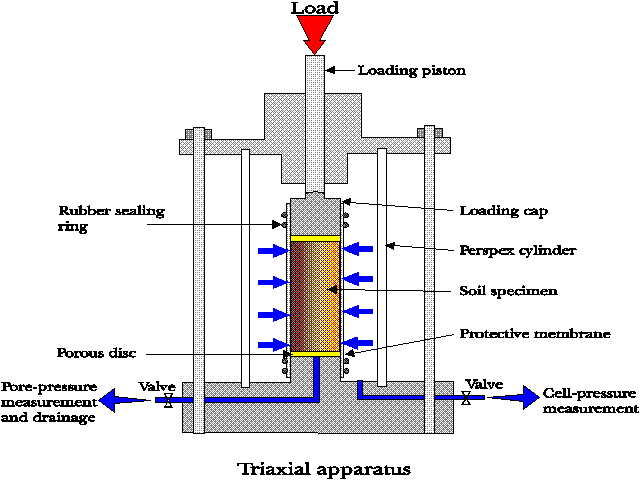Concept
Description and Procedure
Conventional triaxial test involves subjecting a cylindrical soil sample to radial stresses (confining pressure) and controlled increases in axial stresses or axial displacements. The cylindrical soil specimen is usually of the dimension of 100 mm diameter and 200 mm height. The specimen in vertically enclosed in a thin rubber membrane. The specimen preparation depends on the type of the soil. Samples of cohesive soils are often prepared directly from saturated compacted samples, either undisturbed or remolded. For cohesion-less soils, however, the specimen is prepared with the help of a mold that maintains the required shape of the specimen.
The specimen is vertically enclosed with a thin rubber membrane and placed between two rigid ends inside a pressure chamber. The upper plate can move vertically and apply vertical stresses to the specimen. The axial strain/stress of the sample is controlled through the movement of this vertical axis. Also, the confining pressure is controlled by the water pressure surrounding the sample in the pressure chamber. The volume change of the sample is also controlled by measuring the exact volume of moving water.
Depending on the combination of loading and drainage condition, three main types of triaxial tests can be carried out:
- Consolidated – Drained (CD)
- Consolidated – Undrained (CU)
- Unconsolidated - Undrained (UU)
In case of consolidated test, the test is then carried out by a first stage of applying confining pressure in the pressure chamber and allowing drainage of the sample. This stage corresponds to the consolidation of the sample. The deviatoric load is then applied through the vertical axis. The deviatoric stress is indeed the difference between the vertical stress and the confining stress. During the deviatoric compression, the drainage valves can be open (CD) or closed (CU & UU).
Triaxial test data, in general, include evolution of axial and volumetric strain, deviatoric and isotropic stress, and pore pressure evolution. From the triaxial test results, it is possible to deduce the shear strength parameters, namely friction angle, cohesion, dilatancy angle and the other dependent parameters.
Standards
- BS 1377-7:1990
- ASTM D4767 - 04 Standard Test Method for Consolidated Undrained Triaxial Compression Test for Cohesive Soils Link
- ASTM D2850 - 03a(2007) Standard Test Method for Unconsolidated-Undrained Triaxial Compression Test on Cohesive Soils Link
References - External Links
- Principles of Triaxial Tests , Chap 7.6 of Experimental Soil Mechanic, Bardet, J. P., Experimental Soil Mechanics, 1997, Prentice-Hall, Upper Saddle River, New Jersey.
- Detailed description of Triaxial Tests on Coarse-Grained soils , Chap 7.7 of Experimental Soil Mechanic Bardet, J. P., Experimental Soil Mechanics, 1997, Prentice-Hall, Upper Saddle River, New Jersey.
- Detailed description of Triaxial Tests on Fine-Grained soils , Chap 7.8 of Experimental Soil Mechanic Bardet, J. P., Experimental Soil Mechanics, 1997, Prentice-Hall, Upper Saddle River, New Jersey.
- Triaxial Shear Test on Wikipedia
- Concept of Triaxial Shear test and detailed description of UU triaxial test, Binod Tiwari, Soil Mechanics Laboratory, California State University, Fullerton
- Conceptual description of drained and undrained triaxial tests, Dipartimento di Ingegneria Idraulica Marittima Ambientale Geotecnica - UNIVERSITÀ DI PADOVA
- Displacement measurement with laser scanning in triaxial testing apparatuses, Ernst Bleiker, Sophie Messerklinger, S.M. Springman, Adrian Zweidler. 2004. Institute for Geotechnical Engineering, Swiss Federal Institute of Technology Zurich Link
- Simple triaxial cell for field or laboratory testing of rock, J.A. Franklin, E. Hoek.1968. Trans. Instn Min. Metall. 77, A22- 26.

